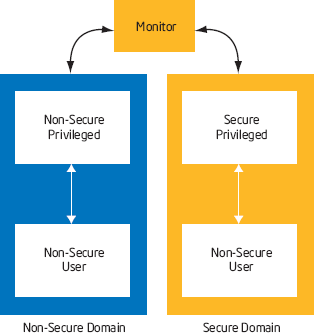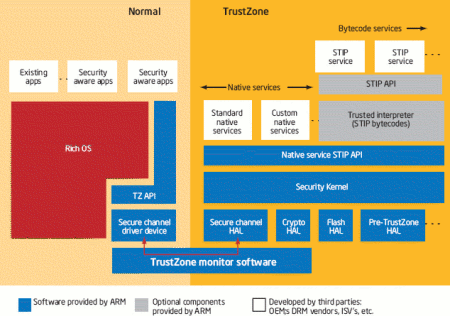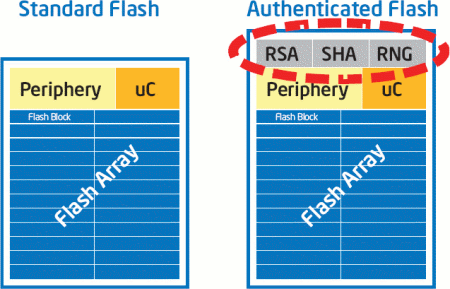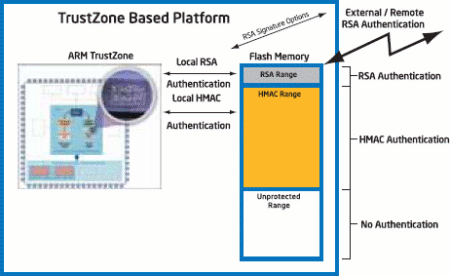Intel, ARM collaborate on device security
Oct 15, 2007 — by LinuxDevices Staff — from the LinuxDevices Archive — 30 viewsARM Ltd. and Intel are collaborating on a set of hardware and software technologies aimed at improving security in devices such as mobile phones, PDAs, and set-top boxes. The effort will integrate ARM's TrustZone hardware/software authentication with Intel's Authenticated Flash memory, targeting next-generation system-on-chip (SoC) designs, according to the companies.
ARM launched TrustZone in 2003, touting it as a hardware mechanism for cordoning off designated areas of on- and off-chip memory, for exclusive use by “trusted” data and applications. TrustZone can be used to establish a “parallel world” in which trusted programs and data can work and live in isolation from a device's rich OS, including at boot time, ARM says.

TrustZone architecture concept
TrustZone was launched as a standard component of ARM's ARM1176-JZ core, and is also standard in the company's later Cortex-A8 and Cortex-A9 cores. TrustZone is also available as an add-on to ARM7 and ARM9 cores.
In addition to a hardware component, TrustZone includes a configurable, portable software stack exposing a TrustZone Software API for custom application access. Suggested applications include access control, secure storage, crytpographic services, and integrity checking for secure boot, SIMLock, and IMEI (international mobile equipment identity) protection. Additionally, there's an optional STIP (small terminal interoperability platform) smartcard interface.

ARM TrustZone stack components
(Click to enlarge)
According to ARM, Intel's Authenticated Flash, interposes hardware cryptographic engines directly in front of the flash memory device, with the goals of preventing unauthorized modifications, providing hardware access control, and supporting protected key storage.

Standard flash (left) and Intel Authenticated Flash (right)
(Click to enlarge)
ARM and Intel say that in practice, integrating their respective products is “simple and straightforward,” despite “many variations.” An HMAC (hash-keyed message authentication code) can be shared between the SoC and the flash, permanently binding them together. Alternatively, an RSA public key can be installed on the flash device, with the private key “available locally or maintained external to the specific device.” Or, both approaches may be combined, as depicted below.
TrustZone and Authenticated Flash configured for both RSA and HMAC authentication
Touted benefits of the combined technologies are said to include:
- SoC resources can be reduced (i.e., crytographic hardware may not be needed).
- No need for separate, secure ROM (read-only memory) devices, such as a boot ROM, since the authenticated memory can provide “equivalent protection.”
- Less RAM may be needed, as the setup supports “direct execution” techniques (i.e., XIP, or execute-in-place). ARM says, “applications that reside in external flash, but are integrity checked before being loaded into SoC RAM can instead remain in external authenticated flash and be directly executed. The need for secure RAM is then limited to the needs such as stack, heap, and dynamic data.”
- “Key fuses” can be reduced. “A single key stored on the SoC can be used to bind the flash to the host processor. All other keys needed by the system can be protected by the authenticated memory,” ARM says.
Jim McGregor, research director at In-Stat, stated, “The need for security protection of wireless applications represents a significant issue for the embedded world. With complementary technologies from players like ARM and Intel, In-Stat believes the industry is heading in a positive direction.”
Tiago Alves, security solutions manager at ARM, stated, “We are enabling system security by integrating protective measures into the heart of our processors and providing secure software to complemeft the efforts of our partners.”
Availability
The combined technology is available now, and supports “open” OSes such as Linux, Symbian, and Windows CE, according to ARM. Additional details are available in a PDF whitepaper on the combined products, currently available both from ARM and from Intel.
This article was originally published on LinuxDevices.com and has been donated to the open source community by QuinStreet Inc. Please visit LinuxToday.com for up-to-date news and articles about Linux and open source.
